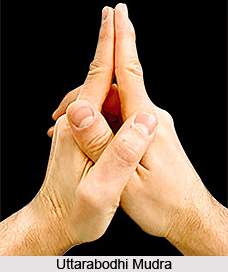 Uttarabodhi mudra is the gesture of perfection. It is called the best-perfection among the types of mudras. In this mudra, all fingers are intertwined. It is said that Shakyamuni Buddha is the liberator of the Nagas present this mudra. Moreover, the Uttarabodhi mudra is frequently seen in images of Vairochana. This mudra can essentially be called the mudra of enlightenment. As the sun of enlightenment dawns, fears are dispelled.
Uttarabodhi mudra is the gesture of perfection. It is called the best-perfection among the types of mudras. In this mudra, all fingers are intertwined. It is said that Shakyamuni Buddha is the liberator of the Nagas present this mudra. Moreover, the Uttarabodhi mudra is frequently seen in images of Vairochana. This mudra can essentially be called the mudra of enlightenment. As the sun of enlightenment dawns, fears are dispelled.
Steps of Uttarabodhi Mudra
The process involves the extension of index fingers straight up and together. Both hands are held at the level of the chest, the two raised index fingers touch one another; the remaining fingers are crossed and folded down. The thumbs touch each other at the tips or are also crossed and folded. In order to practise Uttarabodhi mudra, both hands should be placed in front of the solar plexus. The index fingers and thumbs of both hands should be laid on each other. The index fingers should point upwards and the thumb downward. It can be held for any length of time. Uttarabodhi mudra can be practiced for 15 minutes 1-3 times a day. It can be performed by anyone but make sure to consult with the doctor before practicing.
Benefits of Uttarabodhi Mudra
•Uttarabodhi mudra evokes a sense of unshaken unity within oneself in aligning with the one source.
•This mudra refreshes the system and charges it with energy.
•It helps to soothe excited nerves before beginning a daunting task.
•It enables the performer to overcome stage fright.
•It can be practiced for fearlessness.
•This mudra is helpful for people who lack self confidence and suffer from fear of interacting with many people at a time.
•This mudra can also be practiced by students who feel jittery before exams or people who get nervous before job interviews.
•Practicing this mudra is said to give an inspiration flash for problem solving.
•It calms the mind and is useful for stirring insight, inspiration and decision-making.
•It purifies the body and mind and shields them from negative forces.
•It helps to get rid of stress and improves concentration.




















